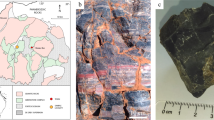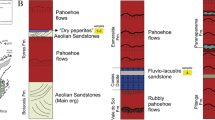Abstract
The 3,465-million year-old Apex chert of the Pilbara Craton in Western Australia has been controversially reported to contain some of the oldest fossil evidence for life: tiny carbonaceous filaments interpreted as cyanobacteria1. Yet, on the basis of the presence of barite and native metals, it has been suggested that the chert formed from hydrothermal fluids at temperatures greater than 250 ∘C (refs 2, 3), an unlikely environment for cyanobacteria. Here we use scanning electron microscopy to assess the mineralogy and depositional setting of the chert veins surrounding the nodes that contain the microfossils. In addition to rare native metals, we find an assemblage of iron oxides and clay minerals, which we interpret to have formed during repeated pulses of hydrothermal alteration at low to medium temperatures. We also find micrometre-sized silica structures that resemble microbial exopolymers4, and textures formed by the partial dissolution of tubular minerals that look similar to fossilized microbial mats5. Other branched microstructures suggest post-depositional colonization of microcracks and fissures by microbes5. These observations are not directly applicable to the carbonaceous filaments purported to be the earliest fossil evidence of life, as we did not recover any in our sample. However, because of the observed hydrothermal and groundwater alteration, we conclude that the Apex chert is unlikely to have preserved any early forms of life.
This is a preview of subscription content, access via your institution
Access options
Subscribe to this journal
Receive 12 print issues and online access
$259.00 per year
only $21.58 per issue
Buy this article
- Purchase on Springer Link
- Instant access to full article PDF
Prices may be subject to local taxes which are calculated during checkout


Similar content being viewed by others
Change history
22 November 2009
It has been brought to our attention that the second sentence of the last paragraph on page 641 of this Letter and the sentence beginning "The microstructures are also present" in line 10 on page 642 of this Letter could be ambiguous. Both sentences have been amended in the HTML and PDF versions of the Letter.
References
Schopf, J. W. Microfossils of the early Archean Apex chert: New evidence of the antiquity of life. Science 260, 640–646 (1993).
Brasier, M. D. et al. Questioning the evidence for Earth’s oldest fossils. Nature 416, 76–81 (2002).
Brasier, M. et al. Critical testing of Earth’s oldest putative fossil assemblage from the ∼3.5 Ga Apex chert, Chinaman Creek, Western Australia. Precambr. Res. 140, 55–102 (2005).
Westall, F. et al. Implications of a 3.472–3.333 Gyr-old subaerial microbial mat from the Barberton greenstone belt, South Africa for the UV environmental conditions on the early Earth. Phil. Trans. R. Soc. B 361, 1857–1875 (2006).
Westall, F. & Folk, R. L. Exogenous carbonaceous microstructures in Early Archaean cherts and BIFs from the Isua Greenstone Belt: Implications for the search for life in ancient rocks. Precambr. Res. 126, 313–330 (2003).
Schopf, J. W. The Cradle of Life (Princeton Univ. Press, 1999).
Van Kranendonk, M. J. & Pirajno, F. Geochemistry of metabasalts and hydrothermal alteration zones associated with c. 3.45 Gyr chert and barite deposits: Implications for the geological setting of the Warrawoona group, Pilbara Craton, Australia. Geochem. Explor. Environ. Anal. 4, 253–278 (2004).
Van Kranendonk, M. J. Volcanic degassing, hydrothermal circulation and the flourishing of early life on Earth: A review of the evidence from c. 3,490–3,240 Ma rocks of the Pilbara Supergroup, Pilbara Craton, Western Australia. Earth Sci. Rev. 74, 197–240 (2006).
Schopf, J. W., Kudryavtsev, A. B., Agresti, D. G., Wdowiak, T. J. & Czaja, A. D. Laser-Raman imagery of Earth’s earliest fossils. Nature 416, 73–76 (2002).
Strauss, H. & Moore, T. B. in The Proterozoic Biosphere (eds Schopf, J. W. & Klein, C.) 709–798 (Cambridge Univ. Press, 1992).
Orberger, B. et al. in Processes on the Early Earth: Geol. Soc. Am. Spec. Paper 405 (eds Reimold, W. U. & Gibson, R. L.) 133–156 (GSA, 2006).
Brophy, G. P., Scott, E. S. & Snellgrove, R. A. Sulfate studies II. Solid solution between alunite and jarosite. Am. Mineral. 47, 112–126 (1962).
Dequincey, O., Chabaux, F., Leprun, J. C. & Paquet, H. Lanthanide and trace element mobilization in a lateritic toposequence: Inferences from the Kaya laterite in Burkina Faso. Eur. J. Soil Sci. 57, 816–830 (2006).
Squyres, S. W. & Knoll, A. H. Sedimentary rocks at Meridiani Planum: Origin, diagenesis, and implications for life on Mars. Earth Planet. Sci. Lett. 240, 1–10 (2005).
Golden, D. C., Ming, D. W., Morris, R. C. & Graff, T. G. Hydrothermal synthesis of hematite spherules and jarosite: Implications for diagenesis and hematite spherule formation in sulfate outcrops at Meridiani Planum, Mars. Am. Mineral. 93, 1201–1214 (2008).
Quantin, P., Gautheyrou, J. & Lorenzoni, P. Halloysite formation through in situ weathering of volcanic glass from trachytic pumices, Vico’s volcano, Italy. Clay Miner. 23, 423–437 (1988).
Rye, R. A review of the stable-isotope geochemistry of sulfate minerals in selected igneous environments and related hydrothermal systems. Chem. Geol. 215, 5–36 (2005).
John, D. A., Sisson, T. W., Breit, G. N., Rye, R. O. & Vallance, J. W. Characteristics, extent and origin of hydrothermal alteration at Mount Rainier Volcano, Cascades Arc, USA: Implications for debris-flow hazards and mineral deposits. J. Volcanol. Geotherm. Res. 175, 289–314 (2008).
Geptner, A. R., Ivanovskaya, T. A. & Pokrovskaya, E. V. Hydrothermal fossilization of microorganisms at the Earth’s surface in Iceland. Lithol. Miner. Resour. 40, 505–520 (2005).
Mukhopadhyay, J., Gutzmer, J. & Beukes, N. Organotemplate silica deposition in Neoproterozoic deep-marine environments: Evidence from the Penganga Group, Adilabad, India. Terra Nova 16, 338–343 (2004).
Allen, C. C. et al. Microscopic physical biomarkers in carbonate hot springs: Implications in the search for life on Mars. Icarus 147, 49–67 (2000).
Tobler, D. J., Stefansson, A. & Benning, L. G. In-situ grown silica sinters in Icelandic geothermal areas. Geobiology 6, 481–502 (2008).
Li, J. & Kusky, T. M. World’s largest known Precambrian fossil black smoker chimneys and associated microbial vent communities, North China: Implications for early life. Gondwana Res. 12, 84–100 (2007).
Handley, K., Turner, S., Campbell, K. & Mountain, B. Silicifying biofilm exopolymers on a hot-spring microstromatolite: Templating nanometer-thick laminae. Astrobiology 8, 747–770 (2008).
Geptner, A. R. & Protasevich, L. T. Fossilized filamentous microbiota in volcanosedimentary deposits in Iceland. Lithol. Miner. Resour. 35, 278–287 (2000).
Buick, R. in Planets and Life: The Emerging Science of Astrobiology (eds Sullivan, W. & Baross, J.) 237–264 (Cambridge Univ. Press, 2007).
Buick, R. Carbonaceous filaments from North Pole, Western Australia: Are they fossil bacteria in Archaean stromatolites? Precambr. Res. 24, 157–172 (1984).
Acknowledgements
We wish to thank P. Philippot for donating the Apex chert sample PI-02-07. Discussions with V. Altermann, N. Grassineau, T. Kakegawa, S. Kesler, R. Maranger, M. Van Kranendonk, J. Valley and Y. Watanabe were greatly appreciated. The project was supported by NSERC Discovery Grant grant no. 314496 to D.L.P. This is GEOTOP contribution 2009-0015.
Author information
Authors and Affiliations
Contributions
D.L.P., R.M. and V.C. contributed equally to the analyses of Apex chert. R.M. treated SEM imagery. D.L.P. wrote the manuscript.
Corresponding author
Supplementary information
Supplementary Information
Supplementary Information (PDF 800 kb)
Rights and permissions
About this article
Cite this article
Pinti, D., Mineau, R. & Clement, V. Hydrothermal alteration and microfossil artefacts of the 3,465-million-year-old Apex chert. Nature Geosci 2, 640–643 (2009). https://doi.org/10.1038/ngeo601
Received:
Accepted:
Published:
Issue Date:
DOI: https://doi.org/10.1038/ngeo601
This article is cited by
-
Late Paleozoic gravity flow depositional systems in the Mandula Basin of the Solonker Belt, Inner Mongolia, China: towards a volcanic-associated submarine environment
International Journal of Earth Sciences (2020)
-
Challenges in evidencing the earliest traces of life
Nature (2019)



